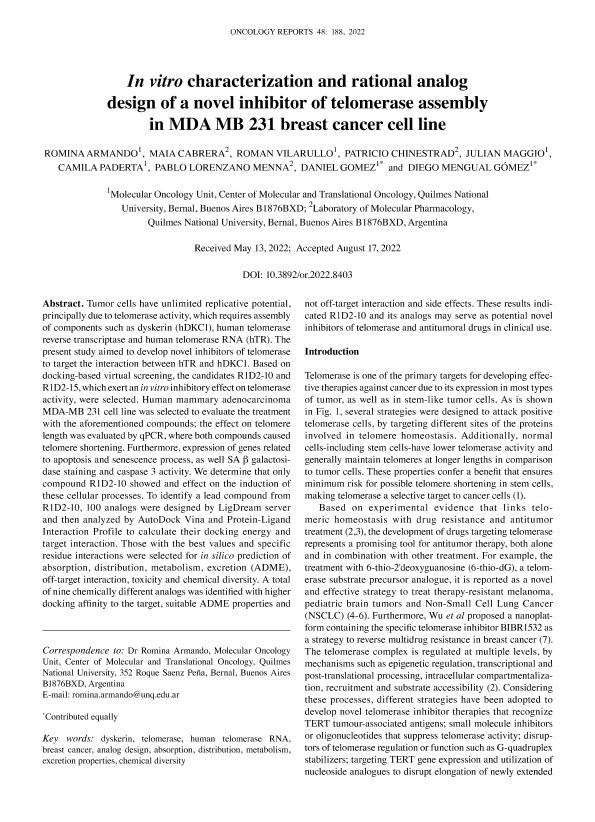Mostrar el registro sencillo del ítem
dc.contributor.author
Armando, Romina Gabriela

dc.contributor.author
Cabrera, Maia Diana Eliana

dc.contributor.author
Vilarullo, Roman Nicolas

dc.contributor.author
Chinestrad, Patricio Manuel

dc.contributor.author
Maggio, Julian

dc.contributor.author
Paderta, Camila
dc.contributor.author
Lorenzano Menna, Pablo

dc.contributor.author
Gomez, Daniel Eduardo

dc.contributor.author
Mengual Gómez, Diego Luis

dc.date.available
2023-02-09T13:27:27Z
dc.date.issued
2022-11
dc.identifier.citation
Armando, Romina Gabriela; Cabrera, Maia Diana Eliana; Vilarullo, Roman Nicolas; Chinestrad, Patricio Manuel; Maggio, Julian; et al.; In vitro characterization and rational analog design of a novel inhibitor of telomerase assembly in MDA MB 231 breast cancer cell line; Spandidos Publications; Oncology Reports; 48; 5; 11-2022; 1-15
dc.identifier.issn
1021-335X
dc.identifier.uri
http://hdl.handle.net/11336/187469
dc.description.abstract
Tumor cells have unlimited replicative potential, principally due to telomerase activity, which requires assembly of components such as dyskerin (hDKC1), human telomerase reverse transcriptase and human telomerase RNA (hTR). The present study aimed to develop novel inhibitors of telomerase to target the interaction between hTR and hDKC1. Based on docking‑based virtual screening, the candidates R1D2‑10 and R1D2‑15, which exert an in vitro inhibitory effect on telomerase activity, were selected. Human mammary adenocarcinoma MDA‑MB 231 cell line was selected to evaluate the treatment with the aforementioned compounds; the effect on telomere length was evaluated by qPCR, where both compounds caused telomere shortening. Furthermore, expression of genes related to apoptosis and senescence process, as well SA β galactosi‑ dase staining and caspase 3 activity. We determine that only compound R1D2‑10 showed and effect on the induction of these cellular processes. To identify a lead compound from R1D2‑10, 100 analogs were designed by LigDream server and then analyzed by AutoDock Vina and Protein‑Ligand Interaction Profile to calculate their docking energy and target interaction. Those with the best values and specific residue interactions were selected for in silico prediction of absorption, distribution, metabolism, excretion (ADME), off‑target interaction, toxicity and chemical diversity. A total of nine chemically different analogs was identified with higher docking affinity to the target, suitable ADME properties and not off‑target interaction and side effects. These results indi‑ cated R1D2‑10 and its analogs may serve as potential novel inhibitors of telomerase and antitumoral drugs in clinical use.
dc.format
application/pdf
dc.language.iso
eng
dc.publisher
Spandidos Publications

dc.rights
info:eu-repo/semantics/openAccess
dc.rights.uri
https://creativecommons.org/licenses/by-nc-sa/2.5/ar/
dc.subject
ABSORPTION
dc.subject
ANALOG DESIGN
dc.subject
BREAST CANCER
dc.subject
CHEMICAL DIVERSITY
dc.subject
DISTRIBUTION
dc.subject
DYSKERIN
dc.subject
EXCRETION PROPERTIES
dc.subject
HUMAN TELOMERASE RNA
dc.subject
METABOLISM
dc.subject
TELOMERASE
dc.subject.classification
Otras Ciencias de la Salud

dc.subject.classification
Ciencias de la Salud

dc.subject.classification
CIENCIAS MÉDICAS Y DE LA SALUD

dc.title
In vitro characterization and rational analog design of a novel inhibitor of telomerase assembly in MDA MB 231 breast cancer cell line
dc.type
info:eu-repo/semantics/article
dc.type
info:ar-repo/semantics/artículo
dc.type
info:eu-repo/semantics/publishedVersion
dc.date.updated
2023-02-08T15:30:37Z
dc.journal.volume
48
dc.journal.number
5
dc.journal.pagination
1-15
dc.journal.pais
Grecia

dc.journal.ciudad
Atenas
dc.description.fil
Fil: Armando, Romina Gabriela. Universidad Nacional de Quilmes. Departamento de Ciencia y Tecnología. Laboratorio de Oncología Molecular; Argentina. Consejo Nacional de Investigaciones Científicas y Técnicas; Argentina
dc.description.fil
Fil: Cabrera, Maia Diana Eliana. Universidad Nacional de Quilmes. Departamento de Ciencia y Tecnologia. Laboratorio de Farmacologia Molecular.; Argentina. Consejo Nacional de Investigaciones Científicas y Técnicas; Argentina
dc.description.fil
Fil: Vilarullo, Roman Nicolas. Universidad Nacional de Quilmes. Departamento de Ciencia y Tecnología. Laboratorio de Oncología Molecular; Argentina
dc.description.fil
Fil: Chinestrad, Patricio Manuel. Universidad Nacional de Quilmes. Departamento de Ciencia y Tecnologia. Laboratorio de Farmacologia Molecular.; Argentina. Consejo Nacional de Investigaciones Científicas y Técnicas; Argentina
dc.description.fil
Fil: Maggio, Julian. Universidad Nacional de Quilmes. Departamento de Ciencia y Tecnología. Laboratorio de Oncología Molecular; Argentina. Consejo Nacional de Investigaciones Científicas y Técnicas; Argentina
dc.description.fil
Fil: Paderta, Camila. Universidad Nacional de Quilmes. Departamento de Ciencia y Tecnología. Laboratorio de Oncología Molecular; Argentina
dc.description.fil
Fil: Lorenzano Menna, Pablo. Universidad Nacional de Quilmes. Departamento de Ciencia y Tecnologia. Laboratorio de Farmacologia Molecular.; Argentina. Consejo Nacional de Investigaciones Científicas y Técnicas; Argentina
dc.description.fil
Fil: Gomez, Daniel Eduardo. Universidad Nacional de Quilmes. Departamento de Ciencia y Tecnología. Laboratorio de Oncología Molecular; Argentina. Consejo Nacional de Investigaciones Científicas y Técnicas; Argentina
dc.description.fil
Fil: Mengual Gómez, Diego Luis. Universidad Nacional de Quilmes. Departamento de Ciencia y Tecnología. Laboratorio de Oncología Molecular; Argentina. Consejo Nacional de Investigaciones Científicas y Técnicas; Argentina
dc.journal.title
Oncology Reports

dc.relation.alternativeid
info:eu-repo/semantics/altIdentifier/url/http://www.spandidos-publications.com/10.3892/or.2022.8403
dc.relation.alternativeid
info:eu-repo/semantics/altIdentifier/doi/http://dx.doi.org/10.3892/or.2022.8403
Archivos asociados
